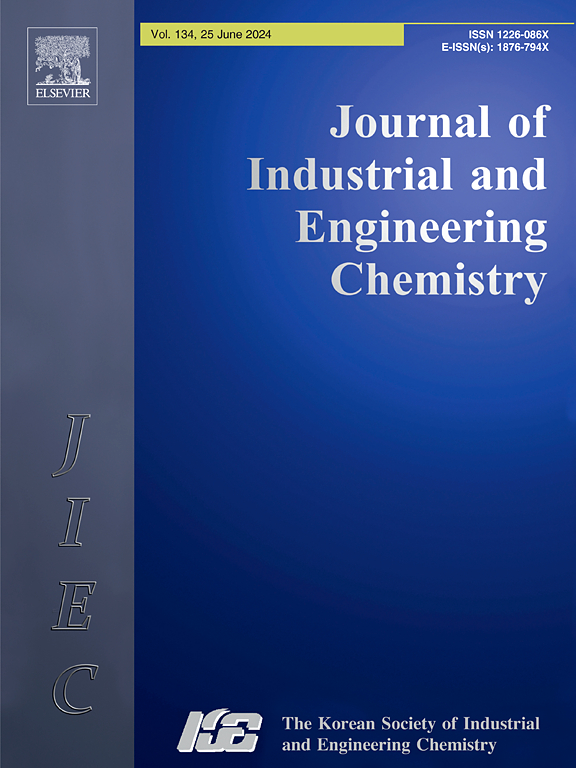通过水热炭化抗坏血酸制备的小尺寸碳纳米球:一种增强Cu纳米晶体电化学传感器性能的有效支撑材料
IF 5.9
3区 工程技术
Q1 CHEMISTRY, MULTIDISCIPLINARY
Journal of Industrial and Engineering Chemistry
Pub Date : 2025-06-28
DOI:10.1016/j.jiec.2025.06.051
引用次数: 0
摘要
本研究开发了一种低温、环保的水热炭化方法来合成小尺寸碳纳米球[C(s) Ns]。研究表明,C(s) Ns作为一种有效的支撑材料,可以提高铜纳米晶体的传感器性能。与纯Cu相比,C@Cu Ns对葡萄糖、亚硝酸钠和甲醛的传感性能有所提高。对传感器性能增强的机理进行了综合分析。此外,系统地研究了Cu加载速率和碳纳米管尺寸对传感器性能的影响。在碱性溶液中,C(s)@Cu-8% [C(s) Ns与Cu 8的负载率为%]检测葡萄糖和甲醛的灵敏度分别是Cu纳米晶体的1.94倍和3.06倍。在中性溶液中,C(s)@Cu-8%检测NaNO2的灵敏度比Cu纳米晶体高3.49倍。将所得的C(s)@Cu Ns应用于实际物质中,可以实现对水溶液中NaNO2和雀巢咖啡中糖含量的检测。本工作介绍了一种具有多功能和增强性能的经济型传感器,在保持成本效益的同时提高了铜纳米晶体的利用效率。解决了高浓度葡萄糖和亚硝酸盐检测的要求。本文章由计算机程序翻译,如有差异,请以英文原文为准。
Small-sized carbon nanospheres via hydrothermal carbonization of ascorbic acid: An efficient supporting material for enhancing Cu nanocrystals electrochemical sensor performance
This work developed low-temperature and environmentally friendly hydrothermal carbonization approach for synthesizing small-sized carbon nanospheres [C(s) Ns]. It is demonstrated that C(s) Ns act as an efficient supporting material, thereby enhancing the sensor performance of Cu nanocrystals. Compared to pure Cu, the C@Cu Ns show enhanced sensor performance toward glucose, sodium nitrite, and formaldehyde. A comprehensive analysis was carried out to investigate the mechanism of enhanced sensor performances. Furthermore, the effects of Cu loading rates and the sizes of C Ns on sensor performance were systematically examined. In alkaline solutions, the sensitivity of C(s)@Cu-8% [ C(s) Ns with Cu 8 at% loading rate] in detecting glucose and formaldehyde was 1.94-fold and 3.06-fold higher than that of Cu nanocrystals, respectively. In neutral solutions, the sensitivity of C(s)@Cu-8% for detecting NaNO2 was 3.49-fold higher than that of Cu nanocrystals. As applied in actual substances, the obtained C(s)@Cu Ns could achieve the detection of NaNO2 in aqueous solutions and sugar content in Nescafé. This work introduced an economical sensor that features multifunctionality and enhanced performance, the utilization efficiency for Cu nanocrystals was enhanced while maintaining cost-effectiveness. Both the requirements for high-concentration glucose and nitrite detection were addressed.
求助全文
通过发布文献求助,成功后即可免费获取论文全文。
去求助
来源期刊
CiteScore
10.40
自引率
6.60%
发文量
639
审稿时长
29 days
期刊介绍:
Journal of Industrial and Engineering Chemistry is published monthly in English by the Korean Society of Industrial and Engineering Chemistry. JIEC brings together multidisciplinary interests in one journal and is to disseminate information on all aspects of research and development in industrial and engineering chemistry. Contributions in the form of research articles, short communications, notes and reviews are considered for publication. The editors welcome original contributions that have not been and are not to be published elsewhere. Instruction to authors and a manuscript submissions form are printed at the end of each issue. Bulk reprints of individual articles can be ordered. This publication is partially supported by Korea Research Foundation and the Korean Federation of Science and Technology Societies.

 求助内容:
求助内容: 应助结果提醒方式:
应助结果提醒方式:


